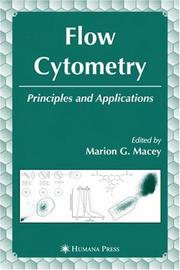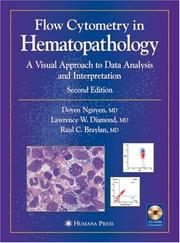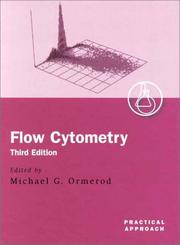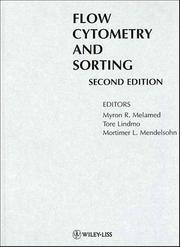| Listing 1 - 10 of 17 | << page >> |
Sort by
|
Book
ISBN: 9535125516 9535154451 9535125508 Year: 2016 Publisher: IntechOpen
Abstract | Keywords | Export | Availability | Bookmark
 Loading...
Loading...Choose an application
- Reference Manager
- EndNote
- RefWorks (Direct export to RefWorks)
Flow cytometry - Select Topics is a collection of chapters that illustrate the constantly evolving application of flow cytometry to diverse areas of research or clinical investigations. It includes chapters on the utilization of flow cytometry in the fields of human reproduction and fertility, platelet function, apoptosis, inflammation research, leukemia immunophenotyping, and transplantation.
Flow cytometry. --- Cell counting, Laser --- Cell separation, Laser --- Cell sorting, Laser --- Flow cytofluorometry --- Flow cytophotometry --- Laser cell counting --- Laser cell separation --- Laser cell sorting --- Cytometry --- Medical genetics
Book
ISBN: 9783031108365 Year: 2022 Publisher: Cham Springer International Publishing :Imprint: Springer
Abstract | Keywords | Export | Availability | Bookmark
 Loading...
Loading...Choose an application
- Reference Manager
- EndNote
- RefWorks (Direct export to RefWorks)
Flow cytometry. --- Cell counting, Laser --- Cell separation, Laser --- Cell sorting, Laser --- Flow cytofluorometry --- Flow cytophotometry --- Laser cell counting --- Laser cell separation --- Laser cell sorting --- Cytometry --- Citometria de fluxe
Book
ISBN: 1789233453 1789233445 1838813616 Year: 2018 Publisher: IntechOpen
Abstract | Keywords | Export | Availability | Bookmark
 Loading...
Loading...Choose an application
- Reference Manager
- EndNote
- RefWorks (Direct export to RefWorks)
Flow cytometry's informative potential has been underestimated for many years because of a lack of adequate instruments, automation, reagents, and know-how to approach, integrate, and also substitute other techniques giving single information per assay. In the last decade, flow cytometers have become capable of performing high-throughput screening and high content analysis, evaluating tens of different samples' features in a single run up to 1536 formats on multiple cell populations. The introduction of imaging flow cytometry has filled the gap between flow cytometry and conventional high content imaging screening, putting flow cytometry at the center of many laboratories, which can now cover with a single instrument the vast majority of needs in research programs. The flow cytometry community is a multidisciplinary and diversified group with many different interests and fields of action. These characteristics have prompted the evolution of the techniques, applications, and instruments that allow the use of complex, sophisticated, and standardized and reliable flow cytometric assays in academic and industrial programs.
Flow cytometry. --- Cell counting, Laser --- Cell separation, Laser --- Cell sorting, Laser --- Flow cytofluorometry --- Flow cytophotometry --- Laser cell counting --- Laser cell separation --- Laser cell sorting --- Cytometry --- Medicine --- Health Sciences --- Cell Biology

ISBN: 1280972165 9786610972166 1597454516 1588296911 Year: 2007 Publisher: Totowa, N.J. : Paisley : Humana ; Quantum [distributor],
Abstract | Keywords | Export | Availability | Bookmark
 Loading...
Loading...Choose an application
- Reference Manager
- EndNote
- RefWorks (Direct export to RefWorks)
Flow cytometry forms an integral part of both basic biological research and clinical diagnosis in pathology. This straightforward new volume provides a clear, easy-to-read, and practical manual for both clinicians and non-clinicians at all levels of their careers. The chapter topics range from basic principles to more advanced subjects, such as apoptosis and cell sorting. Throughout Flow Cytometry: Principles and Applications, well-informed expert contributors present theoretical descriptions and practical protocols on this important and complex laboratory technique and its applications. Immunologists and Hematologists in the field of pathology, as well as biological researchers working with both human and animal models will appreciate the simple, clear-cut style in which principles and protocols in this volume are presented, and will refer to this book time and time again for clear and easy-to-follow protocols.
Flow cytometry. --- Cell separation. --- Cell isolation --- Cell segregation --- Cells --- Cytometry --- Separation (Technology) --- Cell counting, Laser --- Cell separation, Laser --- Cell sorting, Laser --- Flow cytofluorometry --- Flow cytophotometry --- Laser cell counting --- Laser cell separation --- Laser cell sorting --- Separation --- Cell separation --- Cytodiagnosis --- Flow cytometry --- Cell Separation --- Flow Cytometry --- Cytologic diagnosis --- Diagnosis, Cytologic --- Diagnostic cytopathology --- Diagnosis, Laboratory --- Pathology, Cellular --- methods

ISBN: 1281339563 9786611339562 1597451622 1588298558 Year: 2007 Publisher: Totowa, N.J. : Humana Press,
Abstract | Keywords | Export | Availability | Bookmark
 Loading...
Loading...Choose an application
- Reference Manager
- EndNote
- RefWorks (Direct export to RefWorks)
Although instrumentation and laboratory techniques for flow cytometry (FCM) immunophenotyping of hematopoietic malignancies are well documented, there is relatively little information on how best to perform data analysis, a critical step in FCM testing. In Flow Cytometry in Hematopathology: A Visual Approach to Data Analysis and Interpretation, three physicians highly experienced in laboratory hematopathology and FCM offer a unique systematic approach to FCM data analysis and interpretation based on the visual inspection of dual parameter FCM graphics. This step-by-step approach to optimal FCM data analysis is demonstrated by means of numerous FCM graphics derived from actual well-documented clinical cases. In this second edition of this well received book, the authors have revised and expanded the text and added more than 100 figures to reflect the recent advances in the field. The focus of the additional material is on the TCR-Vb eight-tube kit which has greatly facilitated the evaluation mature T-cell disorders, and on the DNA dye DRAQ5 for improved grading of malignant lymphoma. The authors also include notes on "tricks of the trade" and pitfalls to avoid. The discussion, covering leukemias, lymphomas, and other conditions, moves from simple to complex specimens, with an emphasis on visual pattern analysis. Richly illustrated and highly instructive, Flow Cytometry in Hematopathology: A Visual Approach to Data Analysis and Interpretation offers clinical pathologists, hematopathologists, and specialists in laboratory medicine a much-needed guide with a practical and logical approach for sharpening their FCM data analysis skills on a wide spectrum of hematologic disorders.
Blood --- Flow cytometry --- Hematopoietic stem cell disorders --- Immunophenotyping --- Pathophysiology. --- Methodology. --- Diagnosis. --- Lymphocyte immunophenotyping --- Lymphocyte subtyping --- Lymphocytes --- Hematopoietic stem cell diseases --- Hematopoietic stem cells --- Cell counting, Laser --- Cell separation, Laser --- Cell sorting, Laser --- Flow cytofluorometry --- Flow cytophotometry --- Laser cell counting --- Laser cell separation --- Laser cell sorting --- Cytometry --- Body fluids --- Fear of blood --- Classification --- Diseases
Book
ISBN: 0199630534 0199630526 Year: 1990 Volume: vol *32 Publisher: Oxford New York Oxford University Press
Abstract | Keywords | Export | Availability | Bookmark
 Loading...
Loading...Choose an application
- Reference Manager
- EndNote
- RefWorks (Direct export to RefWorks)
Histology. Cytology --- Biological microscopy --- Cell counting [Laser ] --- Cell separation [Laser ] --- Cell sorting [Laser ] --- Cytometrie [Stromings] --- Cytométrie de l'écoulement --- Ecoulement [Cytométrie de l' ] --- Flow cytofluorometry --- Flow cytometry --- Flow cytophotometry --- Laser cell counting --- Laser cell separation --- Laser cell sorting --- Stromingscytometrie --- Flow cytometry. --- FLOW CYTOMETRY --- HANDBOOKS

ISBN: 019963825X 0199638241 9780199638246 9780199638253 Year: 2003 Volume: 229 Publisher: Oxford: Oxford university press,
Abstract | Keywords | Export | Availability | Bookmark
 Loading...
Loading...Choose an application
- Reference Manager
- EndNote
- RefWorks (Direct export to RefWorks)
Flow Cytometry 3/e is intended as a handbook for every laboratory that has a bench-top flow cytometer or a fluorescence activated cell sorter. It is an introduction and guide to those new to the field and a first point of reference for experienced practitioners who want to investigate a new technique. The chapter on immunophenotyping - the most important clinical application of flow cytometry - has been strengthened by the addition of a chapter on quality control in the clinical laboratory. The utility of the book in a clinical laboratory has been further enhanced by the addition of a chapter covering ten other clinical applications. Flow cytometry has found increasing application in the field of apoptosis research. A new chapter has been added to cover this important topic. Every flow cytometry laboratory can't afford not to have a copy on the shelf as a first point of reference. The book is not fully comprehensive but it does aim to cover over 90% of the applications of flow cytometry in mammalian biology.
Flow cytometry --- Flow Cytometry --- Histology. Cytology --- Biological microscopy --- Cell counting, Laser --- Cell separation, Laser --- Cell sorting, Laser --- Flow cytofluorometry --- Flow cytophotometry --- Laser cell counting --- Laser cell separation --- Laser cell sorting --- Cytometry --- methods --- Flow cytometry - Handbooks, manuals, etc. --- ophanging (autotechnologie) --- microscopie --- flowcytometrie --- moleculaire biologie
Periodical
ISSN: 15524957 15524949 Year: 2003 Publisher: New York
Abstract | Keywords | Export | Availability | Bookmark
 Loading...
Loading...Choose an application
- Reference Manager
- EndNote
- RefWorks (Direct export to RefWorks)
Flow cytometry --- Cytodiagnosis --- Flow Cytometry. --- Cytodiagnosis. --- Cytométrie de flux. --- Cytodiagnostic. --- Utilisation diagnostique. --- Diagnostic use --- Diagnostic use. --- Cytologic diagnosis --- Diagnosis, Cytologic --- Diagnostic cytopathology --- Cytodiagnoses --- Cytofluorometry, Flow --- Cytometry, Flow --- Flow Microfluorimetry --- Fluorescence-Activated Cell Sorting --- Microfluorometry, Flow --- Cell Sorting, Fluorescence-Activated --- Cell Sortings, Fluorescence-Activated --- Cytofluorometries, Flow --- Cytometries, Flow --- Flow Cytofluorometries --- Flow Cytofluorometry --- Flow Cytometries --- Flow Microfluorometries --- Flow Microfluorometry --- Fluorescence Activated Cell Sorting --- Fluorescence-Activated Cell Sortings --- Microfluorimetry, Flow --- Microfluorometries, Flow --- Sorting, Fluorescence-Activated Cell --- Sortings, Fluorescence-Activated Cell --- Cell counting, Laser --- Cell separation, Laser --- Cell sorting, Laser --- Flow cytofluorometry --- Flow cytophotometry --- Laser cell counting --- Laser cell separation --- Laser cell sorting --- Diagnosis, Laboratory --- Pathology, Cellular --- Cytological Techniques --- Cytometry --- Flow Cytometry --- Cytology --- Cytométrie de flux --- Cytodiagnostics --- Utilisation diagnostique --- Genetics --- Molecular biology --- moleculaire biologie --- Health Sciences --- Life Sciences --- Pathology --- Biology --- Cytology, Cell Biology
Book
ISBN: 3319980718 331998070X Year: 2018 Publisher: Cham : Springer International Publishing : Imprint: Springer,
Abstract | Keywords | Export | Availability | Bookmark
 Loading...
Loading...Choose an application
- Reference Manager
- EndNote
- RefWorks (Direct export to RefWorks)
Flow cytometry allows for the measurement of different aspects of a cell or particles in real time. Applications include quantifying various types of T cells to determine the presence of various immune disorders, such as whether HIV has progressed to AIDS, studying the dynamics of immune signaling in cells to detect the suppression of normal immune function, and analyzing biopsy specimens for tumors, to aid in cancer diagnosis and prognosis. In addition to simplifying the technique and using vocabulary accessible to those not trained in cell biology and immunology, the book includes the following 4 unqiue features: 1) Tips on how to set up an experiment for flow cytometry optimially 2) An expanded data set of flow staining including multiparameter flow cytometry 3) Detailed staining protocols for flow cytometry (ex. protocols optimized for transcription factors, secreted cytokines, phospho-antibodies, and surface antigens) 4) Section devoted to antibody development and conjugation.
Flow cytometry. --- Cell counting, Laser --- Cell separation, Laser --- Cell sorting, Laser --- Flow cytofluorometry --- Flow cytophotometry --- Laser cell counting --- Laser cell separation --- Laser cell sorting --- Cytometry --- Monoclonal antibodies. --- Medical laboratories. --- Antibodies. --- Laboratory Medicine. --- Diagnosis, Laboratory --- Health facilities --- Laboratories --- Antibodies, Monoclonal --- Monoclonal immunoglobulins --- Immunoglobulins --- Molecular cloning --- Laboratory medicine. --- Clinical medicine --- Clinical pathology --- Diagnostic laboratory tests --- Laboratory diagnosis --- Laboratory medicine --- Medical laboratory diagnosis --- Diagnosis --- Pathology --- Antibodies --- Immune globulins --- Immune serum globulin --- Blood proteins --- Globulins --- Plasma cells --- Antibody diversity --- Antigens --- Bacterial immunoglobulin-binding proteins --- Immunoglobulins. --- Diagnosis, Laboratory.

ISBN: 0471562351 Year: 1990 Publisher: New York, NY : Wiley-Liss,
Abstract | Keywords | Export | Availability | Bookmark
 Loading...
Loading...Choose an application
- Reference Manager
- EndNote
- RefWorks (Direct export to RefWorks)
Flow cytometry --- Cell Count --- Cell Separation --- Cytological Techniques --- 57.086 --- Cytologic Technics --- Cytological Technic --- Cytological Technics --- Cytological Technique --- Technic, Cytological --- Technics, Cytological --- Technique, Cytological --- Techniques, Cytological --- Cytologic Technic --- Technic, Cytologic --- Technics, Cytologic --- Cell Biology --- Cell counting, Laser --- Cell separation, Laser --- Cell sorting, Laser --- Flow cytofluorometry --- Flow cytophotometry --- Laser cell counting --- Laser cell separation --- Laser cell sorting --- Cytometry --- 57.086 Cytological and histological techniques --- Cytological and histological techniques --- methods --- Cytology
| Listing 1 - 10 of 17 | << page >> |
Sort by
|

 Search
Search Feedback
Feedback About UniCat
About UniCat  Help
Help News
News